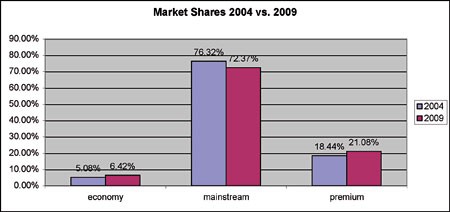With all the talk about downsizing and the new frugality, it is worth looking to see if premium brands are losing share in the recession.
Although some individual manufacturers are clearly having a hard time, there is no evidence that people are turning away from premium brands as such (see graph).
While there has been a slight fall so far this year (which will probably accelerate as the scrappage incentive starts to take effect), the overall share for premium brands is still at its second-highest level ever, and is considerably higher than it was five years ago.
At the other end of the scale value brands are increasing share, which will come as no surprise.
So is this part of the trend, much talked about five or 10 years ago, in which mid-market brands get squeezed from both ends, as people either choose to save money or go for maximum prestige? Only up to a point.
The fact is mid-market brands still account for more than 70% of total sales and successful ones are still increasing market share.
Ford and VW are performing strongly while those which are suffering are doing so for manufacturer-specific reasons. Renault is losing sales to mainstream competitors – it is not losing sales to Audi.
As the German brands move into smaller segments, it is inevitable that the overall premium percentage rises. In fact the three German brands are the only ones that really count in volume terms – Audi, BMW (including Mini) and Mercedes-Benz account for 71.7% of all premium brand sales so far this year. That does not leave a huge number for Lexus, Saab, Volvo et al to fight over.
However, even German premium brands do not have a blank cheque: people want premium badges, providing the premium itself is not too high.
As Audi found with the A2, the car has to be seen to be worth the money – a lesson the company will no doubt have learned in time for the A1.
It is easy to exaggerate the difference between premium and mainstream – and not just because the sales figures of the Big Three Germans are now very mainstream indeed. A Mini is clearly a premium supermini and a Corsa 1.0 is clearly not. But what about a fully loaded Fiesta 1.6 in hot magenta?
Ford has long been the epitome of mainstream but a top spec Fiesta competes with premium competitors. The main difference is that premium manufacturers have a brand while mainstream manufacturers have products.
A brand is a big advantage, but the right product can overcome the lack of a manufacturer brand.
The Qashqai, for example, has clearly not suffered from being fitted with an image-free manufacturer badge.
Market share 2004 v 2009














Login to comment
Comments
No comments have been made yet.